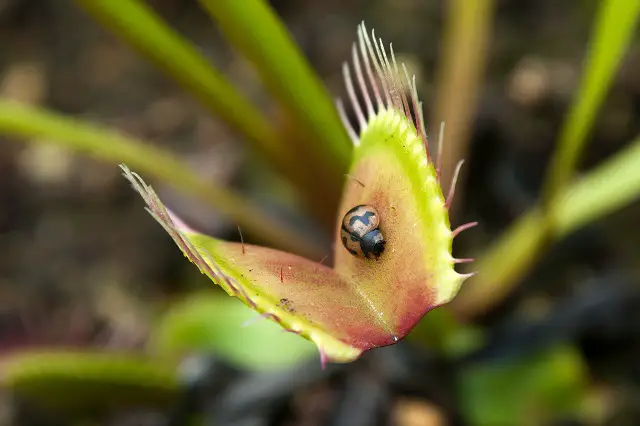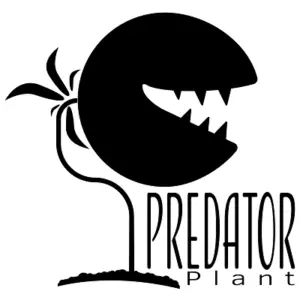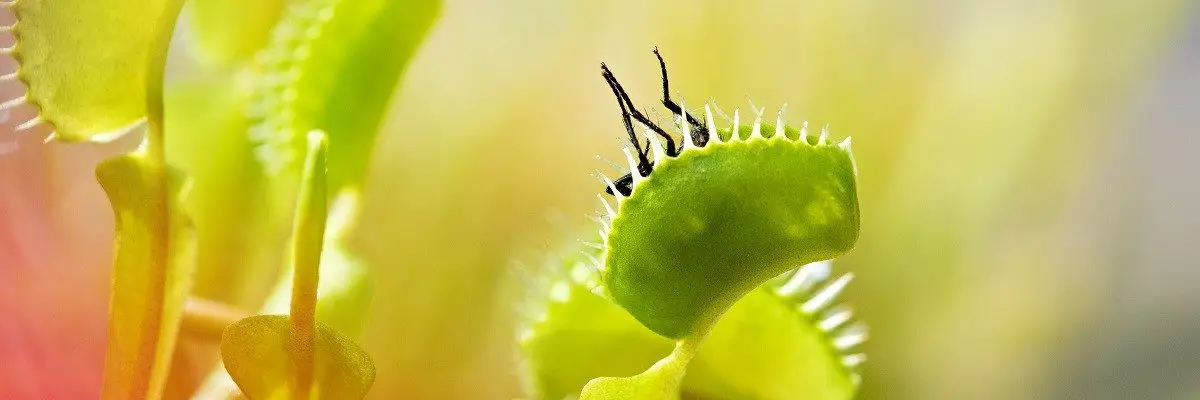Despite its carnivorous nature, flytraps can survive without eating insects for several months at a time. The plants will get enough to eat if they are planted outdoors. You’ll need to feed your Venus flytrap bugs periodically if it’s being grown indoors. You might find feeding your flytrap live flies challenging, but small spiders, beetles, and caterpillars will work. Please don’t give it insects bigger than a third of the size of the trap.
Insects and flies make up the majority of their diet. They must be alive when they capture their prey. In order for the Venus flytrap to close and begin digesting food, the insect must move inside the trap. The trap must also be small enough to close tightly around it to prevent bacteria from entering. Dead flies will not work in the Venus flytrap.
Venus flytraps can survive without bugs for a long period, but eventually, they will need insects for proper nutrition. They won’t grow properly and will become weak.
If Venus flytraps don’t have bugs, how can they survive?
Plants produce their food, which is one of the unique characteristics of the plant kingdom. Photosynthesis is a process by which plants produce food. Photosynthesis is the process of converting carbon and water into food for plants. Insects supplement their diet for Venus flytraps (due to the low nutrient levels in the habitat). They are caught in their traps and digested with enzymes.
Photosynthesis is necessary for Venus flytraps to exist, as it provides fuel for them. However, Venus flytraps grow in nutrient-deficient soil. In such an environment, they do not have a complete diet. By catching and consuming insects, they get that extra boost in nutrition. Their victims contain elements such as nitrogen, phosphorus, and potassium.
What Do Venus Flytraps Eat Naturally?
Venus Flytraps consume many different types of insects in their natural habitat. For instance, the Venus flytrap can consume any small or medium-sized insect. Insects such as crickets, ants, and moths are examples. However, when it comes to feeding, it depends on the size of their traps or “lips.” If it is small, you may find, for example, small crickets, flies, ants, or even cockroaches.
The flytraps with relatively large lips or mouths, on the other hand, can consume larger insects. These prey can include beetles, centipedes, bees, wasps, spiders, etc. About 5% of the Venus flytrap’s diet consists of flying insects, despite the name. They eat wasps and spiders that accidentally crawl into their mouths most of the time.
What else do Venus Flytraps eat?
A common misconception about Venus flytraps is that they can eat meat that we eat every day. Obviously, this isn’t true. Venus flytraps have major issues trying to digest meat, dairy products, and other human foods. Insects are the only food sources for Venus Flytraps. Their digestive systems cannot digest foods other than bugs. A Venus flytrap’s traps will rot if fruits are placed in them. This is because sugar rots roots. Foods such as fast food, eggs, and meat can cause the roots and traps to rot, even killing them. Thus, feeding them only small insects is best to stay safe.
Can Venu Flytraps Eat Dead Bugs?
Inside each Venus, a flytrap trap is three small trigger hairs. As soon as an insect wiggles inside its mouth and touches a hair, it begins a 20-second countdown. During these 20 seconds, if the insects escape, the plant will not close its trap, and it will not consume energy. The trap, however, closes almost immediately without hesitation if the insect touches two hairs simultaneously. The Venus flytraps can be fed dead insects if you make them appear alive. In any other case, the flytraps will not consume them.
It’s because sensitive hairs only send signals to Venus flytraps when they wiggle or move and trigger multiple hairs that something is inside them. When multiple hairs are triggered, they will close their traps when certain there is an insect between them. However, the Venus flytrap does not close its trap for items such as bark or leaves; rather, it uses its energy to catch food.
In other words, you must make them think that the dead insect is still moving. That’s the only way they’ll eat it. Moreover, this is a simple process. Wiggle the insects with a tweezer inside their trap or “lip.” You just need to move it around a bit for the flytrap to catch the bug and eat it.
What is the recommended feeding frequency for Venus flytraps?
Depending on the size of the insect, the Venus flytrap takes between three and five days to digest it. The insect is decomposed by releasing an enzyme from inside its closed lips. Afterward, it draws nutrition and energy from the insect’s body. Upon completing this process, the Venus flytrap releases what remains of the insect’s body.
Outside, your plant could have already consumed a bug, digesting it, and you would not know it. Therefore, it’s best not to feed them every day and only to feed them once or twice a week. Professionals recommend they be fed one or two times a month.
Carnivorous plants go into dormancy during the winter. Because they do not grow or use much energy during this period, they do not require any nutrition. You don’t need to feed them during the winter. During winter dormancy, the plants need to be kept in the dark, enclosed area with little light.

Venus Flytrap dormancy
During the fall months, when growing outdoors, Venus flytraps become dormant. They are able to withstand light freezing temperatures. Nevertheless, prolonged freezes can lead to the death of the Venus flytrap. The Venus Flytrap needs to undergo a dormancy period of three to five months every year in order to grow long-term.
It is recommended that Venus flytraps dormancy for ten weeks at least. Those plants won’t grow well throughout the next growing season if they’re shorter than that. Eventually, Venus flytraps will die if they do not undergo any dormancy. The Venus flytrap should not be placed in a dark or low-light environment unless it is placed in extremely cool conditions (less than 40°F). As much light as possible is necessary to keep Venus flytraps healthy during dormancy. If this is not done, the flytrap will most likely die.
What You Need to Know About Venus Flytrap Feeding
| Only feed one trap at a time. | You should feed your Venus flytrap three to six times a month. By waiting a few weeks during feeding, you will be able to avoid overeating. |
| Seedlings or very tiny Venus flytraps do not need to be fed. If you are unsure as to how to feed them, do not do so. | You should only feed your plant after it has finished its last meal. |
| In the days following the feeding, observe the trap. When the leaf turns black, it indicates that the bug was too big for the trap. Incorrect feeding can cause the leaf to turn black. | Do not feed Venus flytraps during dormancy (the winter season, inactivity). |
Conclusion
The Venus flytrap is a plant that gets most of its nutrition from the soil. Because Venus flytraps’ natural habitat changes so quickly, they have evolved to prey on insects and other living things. Your Venus flytrap will benefit from extra nutrients provided by insects and bugs. Since you can properly maintain the soil where your flytrap lives, you do not need to rely on these insects for nourishment. The soil of your flytrap should be nutrient-dense so that your flytrap won’t need to consume live bugs or insects.

